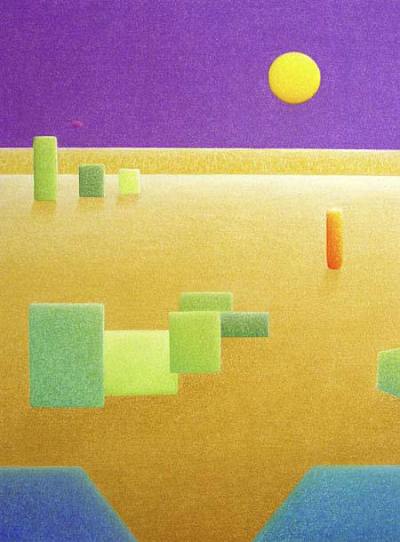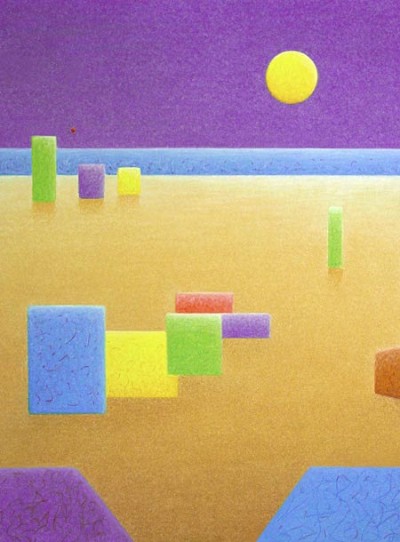Research with forms (color carriers) in an academic context.
Please refer to the Power Point / the forms or color carriers (in French and self explanatory). When these color carriers were viewed by 200 experimental subjects, aged between 18-30 and living in high urban areas, under my supervision, the results were: 99% chose color versus the grays, blend and texture versus flatness, the curves versus the straight lines, asymmetry versus symmetry, transparency versus opacity... This clearly demonstrates the recognition of natural forms as carriers.
Research with color in an academic context (below).


Images that are part of comparison 53 B
Parallel version
Background = red purple / purple
middle ground = the greens (rectangular forms) and red / orange (cylinder)
foreground = blue green (oblique forms)
each element (form) complements one another = the thought process can recognize the visual information because it is found in nature...
Non parallel version
Background = red purple / purple
middle ground = any color (rectangular forms) and green (cylinder)
foreground = the color used by the background and the blue of the middle ground (oblique forms)
each element (form) visually competes with the others = the thought process cannot recognize the visual information because it has no universal references…
The above images were among those viewed by 300 experimental subjects, aged between 18-30 and living in high urban areas, under academic supervision. The experimental results based on a 10 second viewing period were that only 10 to 15% chose the parallel version. I believe that this low recognition factor is due to the pervasive illogical organization of the fabricated world and that the thought process being a solution maker tries to solve the non parallel image. The experimental results based on a 60 second viewing period were that between 55 to 70% chose the parallel version. This demonstrates that with a little time we identify to our universal Origin.
The dichotomy in the results of this research for non-moving 2D images shows that when the duration of the visual exercise is prolonged, the number of people who unconsciously recognize parallel information is increasing. Theoretically speaking, with images moving, the period to recognize parallel information should be reduced.
Unfortunately, non parallel information activates the brain, and makes it search for many non-existent solutions. Such non-participatory experiences prevent the thought process to access solutions to problems. Theory: The confusion caused by this building stress is greatly responsible for awakening negative behaviors. Please refer to the Power Points (parallel versus non parallel images, in French and self explanatory), and the animation “The movement of the thought process”.
PROPOSED RESEARCH CENTER
The following are some of its purposes:
1) To measure the psychological effects of a parallel versus a non parallel environment.
2) To evaluate the adequate level of unified sensory information needed to stimulate the desire to discover, etc.
3) To verify theories like:
a) When surrounded by unified sensory information we can act clearly and almost instantaneously.
b) The majority of the athletes have more precise reflexes in a parallel environment.
c) The majority of the athletes play for a longer period in a parallel environment than a non parallel.
d) Teams have less up and down performances in a parallel environment, etc.
Wishing you unified sensory information,
![]()